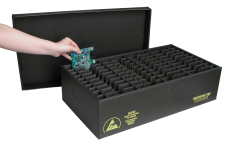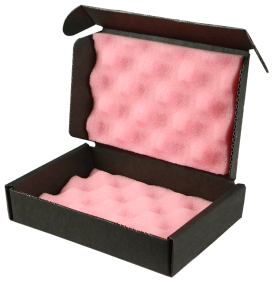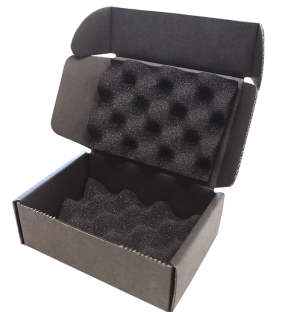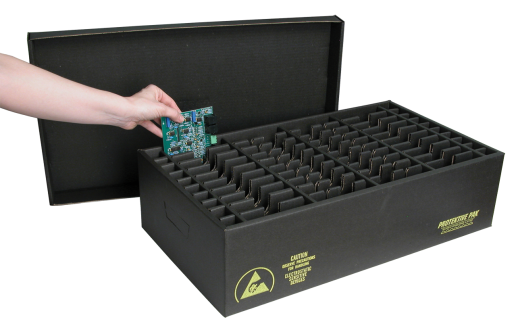Remember the time when Steve Wozniak taught us about ESD?
In 1985 Apple produced a service video that explained the importance of ESD control when servicing an Apple II. Steve Wozniak, a co-founder of Apple computers, was featured in the 26 minute video explaining the handling of ESD susceptible devices. Other than the fact that ESD components are smaller and more sensitive than ever (see the ESDA Electrostatic Discharge (ESD) Technology Roadmap – Revised May 2016), the same principles laid out in the 1985 video hold true today. Take a step back in time:
What is a Faraday Cage?
![lightning-659917_960_720[1]](https://protektivepak.files.wordpress.com/2016/08/lightning-659917_960_7201.jpg?w=311&h=222) A Faraday cage or Faraday shield is an enclosure formed by conducting material or by a mesh of such material. Such an enclosure blocks external static and non-static electric fields. Faraday cages are named after the English scientist Michael Faraday, who invented them in 1836. An impressive demonstration of the Faraday cage effect is that of an aircraft being struck by lightning. This happens frequently, but does not harm the plane or passengers. The metal body of the aircraft protects the interior. For the same reason, a car may be a safe place to be in a thunderstorm.
A Faraday cage or Faraday shield is an enclosure formed by conducting material or by a mesh of such material. Such an enclosure blocks external static and non-static electric fields. Faraday cages are named after the English scientist Michael Faraday, who invented them in 1836. An impressive demonstration of the Faraday cage effect is that of an aircraft being struck by lightning. This happens frequently, but does not harm the plane or passengers. The metal body of the aircraft protects the interior. For the same reason, a car may be a safe place to be in a thunderstorm.

Protektive Pak Impregnated Corrugated Box with lid
ESD control products that provide a Faraday Cage or shielding include Statshield® Metal-In and Metal-Out Shielding Bags, Protektive Pak™ impregnated corrugated with shielding layer when using a lid, and Conductive Totes. Statshield® ESD Smocks creates a Faraday Cage effect around the torso and arms of the operator and shields charges from the operator’s clothing from damaging ESD sensitive devices. (Technically, suppressing the electrical field from clothing worn underneath).
There are standard tests measuring the energy penetration of electrostatic discharges to the interior. The Shielding test method per Packaging standard ANSI/ESD S541 is ANSI/ESD STM11.31 and the required limit is less than 50 nanoJoules of energy.
ESD shielding packaging is to be used particularly when transporting or storing ESD sensitive items outside an ESD Protected Area. Per Packaging standard ANSI/ESD S541 section 6.2 Outside an EPA “Transportation of sensitive products outside of an EPA shall require packaging that provides:
- Low charge generation.
- Dissipative or conductive materials for intimate contact.
- A structure that provides electrostatic discharge shielding.”
Definitions from the ESD Association Glossary ESD ADV1.0 include: Faraday cage “A conductive enclosure that attenuates a stationary electrostatic field.”
Electrostatic discharge (ESD) shield “A barrier or enclosure that limits the passage of current and attenuates an electromagnetic field resulting from an electrostatic discharge.”
Electrostatic shield “A barrier or enclosure that limits the penetration of an electrostatic field.”
Note: the ESD Association sells most documents, however, the Packaging standard ANSI/ESD S541 and the Glossary ESD ADV1.0 are free downloads from www.ESDA.org (click Standards and then Documents, scroll down to find documents that can be downloaded at no charge).
How to Define ESD Protective Packaging Requirements for ESD Sensitive Items
A company with an ANSI/ESD S20.20 ESD control program needs to document the program and define ESD protective packaging for ESD sensitive (ESDS) items. Packaging is to be defined for all material movement within the EPA and for outside the EPA. Best practice is to define the required packaging or material handling item on a product’s bill of materials. The ESD packaging is as important as a component part.
Customer contract packaging can take precedence, but otherwise “the organization shall define ESD protective packaging requirements, both inside and outside the EPA per ANSI/ESD S541.” [ANSI/ESD S20.20 section 8.4]
The ESD Association sells most of their documents. However, both ANSI/ESD S20.20 and ANSI/ESD S541 are available as complimentary downloads from www.ESDA.org.
The fundamentals of ESD control include grounding all conductors in the EPA. ESD packaging will have special material composition to lower the resistance so that when grounded, electrostatic charges will be removed to ground.
This is the Summary of ESD Protective Properties ANSI/ESD S541 Table 2:
| Protection | Property |
| Low charging (antistatic) | Materials that have reduced amounts of charge accumulation as compared with standard packaging materials. |
| Dissipative or Conductive Resistance | Provides an electrical path for charge to dissipate from the package. |
| Discharge Shielding | Protects packaged items from the effects of static discharge that are external to the package. |
ANSI/ESD Table 3 lists Test Methods for Electrostatic Protective Packaging:
| Material Property | Test Method | Method Description | Limits |
| Low Charging (Antistatic) | ESD ADV11.2 | Tribocharging of tubes, planar materials, bags, unit packs (vibration) | User defined |
| Resistance | |||
| Conductive | ANSI/ESD STM11.11 | Surface resistance of planar materials | < 104 ohms |
| ANSI/ESD STM11.12 | Volume resistance of planar materials | < 104 ohms | |
| Dissipative | ANSI/ESD STM11.11 | Surface resistance of planar materials | > 104 to < 1011 ohms |
| ANSI/ESD STM11.12 | Volume resistance of planar materials | > 104 to < 1011 ohms | |
| ANSI/ESD STM11.13 | Surface resistance 2-point electrode | > 104 to < 1011 ohms | |
| Shielding | ANSI/ESD STM11.31 | ESD Shielding of Bags | < 50 nanojoules |
Note that the unit of measurement for conductive and for dissipative is surface or volume resistance in ohms; not resistivity.
Statshield® bag film construction includes a metalized shielding layer. Shielding bags are designed to dissipate electrostatic charges over their surface, protecting ESDS contents from electrostatic fields and from ElectroStatic Discharge (ESD). Their surface resistance is dissipative, which is recommended when packaging in contact with the ESDS; per ANSI/ESD S541 section A.3 “Dissipative Material for Intimate Contact, to avoid rapid discharge to sensitive items, dissipative materials should be used as the layer of packaging that contacts the item.”
This is also true for enclosed Protektive Pak impregnated dissipative corrugated containers, either closed or with lid in place. The impregnated corrugated has a buried shielding layer that provides the shielding ESD control property so that ESD sensitive items can be stored or transported outside an ESD protected area.
Protektive Pak offers a number of ESD control packaging solutions, including Protektive Pak® Impregnated Dissipative Corrugated Products, Statshield Shielding Bags, Moisture Barrier Bags, Pink Poly Bags, and Labels for use within an ESD protected area (EPA) and for shipping outside an EPA. Protektive Pak products are designed to meet ANSI/ESD S20.20 and the ESD Association Packaging standard ANSI/ESD S541; they provide a great value balancing cost and durability.
Reference:
ANSI/ESD S541 for the Protection of Electrostatic Discharge Susceptible Items Packaging Materials for ESD Sensitive Items
Third Party Testing Proves Protektive Pak’s Impregnated Corrugated Material is Superior
Protektive Pak’s Dissipative Impregnated Corrugated material features a unique characteristic, a buried shielding layer. This provides a better value because unlike dissipative or conductive painted material, the buried shielding layer will not rub/scratch off or lose its ESD properties. This translates into a superior, longer lasting ESD safe package.
Third party testing has been performed on Protektive Pak’s Impregnated Corrugated material demonstrating that the buried shielding layer in our corrugated material provides a better value than dissipative or conductive coated (or painted) material.
Proven…
- Protektive Pak impregnated corrugated material has a buried shielding layer
- Protektive Pak impregnated corrugated material equals or exceeds the discharge shielding capabilities of a coated box
- Protektive Pak impregnated corrugated material has discharge shielding capabilities equal to a metal-out shielding bag
- Protektive Pak Dissipative Corrugated Material meets the ANSI/ESD S541 recommendation, avoiding rapid discharge when contacting ESD sensitive items –
conductive coated boxes DO NOT!
Protektive Pak Dissipative Impregnated Corrugated Material meets ANSI/ESD S20.20 and Packaging standard ANSI/ESD S541 tested per ANSI/ESD STM11.11 and modified ANSI/ESD STM11.31
For complete third party test results, click HERE.
Watch our Material Test video:
Pink Vs Black – Use the Right ESD Foam for Your Application
You might have asked yourself, what is the big difference is between pink ESD foam and black ESD foam? The differences are significant, although one is not necessarily better than the other. Which one you choose depends on what your needs are.
Pink Static Dissipative Foam
- Static dissipative polyurethane <1011 ohms
- Antistatic low charging – minimizing electrostatic charge generation
- Provides protection from physical shock during handling, packaging, shipping, and storage of ESD sensitive devices
- Ideal for short term use
- Easy to adapt for custom uses by die-cutting, laminating, etc.

- Non-contaminating, non-corrosive, and non-sloughing
- Economical
Usage Consideration
- Not recommend for lead insertion applications
- When exposed to the environment, the foam will discolor (turn yellow) over time
- Will lose electrical properties over time
Black Conductive Foam
- Conductive polyurethane 1 x 103 to < 1 x 105 ohms per ANSI/ESD STM11.11
- Low density conductive polyurethane foam
- Permanently conductive; will not lose electrical properties – can be used in applications where permanent ESD properties are required
- Provides protection from physical shock during handling, packaging, shipping, and storage of ESD sensitive devices
- Foam will not discolor over time
Usage Consideration
- Better value for long term applications
- Not recommended in applications where Static Dissipative properties are required
While each foam is made of the same material (polyurethane), they have very distinct differences. Which one you use will depend on the application of the foam, how long you intend to use the foam, and even cost considerations.
Learn more about all Protektive Pak foam options. Click Here.
11 Steps to Establishing an ESD Control Plan
1. Define what you are trying to protect.
What is the Human-Body Model (HBM) withstand voltage of the most sensitive item? A prerequisite of ESD control is the accurate and consistent identification of ESD susceptible items. Some companies assume that all electronic components are ESD susceptible. However, others write their ESD control plan based on the device and item susceptibility or withstand voltage of the most sensitive components used in the facility. A general rule is treat any device or component that is received in ESD packaging as an ESD susceptible item.
2. Become familiar with the industry standards for ESD control.
A complimentary .pdf of ANSI/ESD S20.20-2014 can be downloaded from the ESD Association web site at www.ESDA.org. Also consider purchasing the ESDA’s ESD Handbook ESD TR20.20-2008.
3. Select a grounding / equipotential bonding system.
The 3rd-wire AC electrical equipment ground is the preferred, recommended ground reference.
4. Determine the method of ground for operators (Personnel Grounding).
The two options for grounding an operator are a wrist strap or foot grounders. Wrist straps must be worn if the operator is seated. If foot grounders are used, an ESD flooring system must be used. In some cases both wrist strap and foot grounders will be used. The 3rd-wire AC electrical equipment ground is the preferred, recommended ground reference.
5. Establish & Identify EPA(s) – ESD Protected Area(s).
ESD Control Plans must evolve to keep pace with costs, device sensitivities, and the way devices are manufactured. Define the departments and areas to be considered part of the ESD Protected Area. Consider if customers and/or subcontractors should be included. Implement access control devices, signs, and aisle marking tape to identify and control access to the ESD Protected Area(s).
6. Select ESD control items to be used in the EPA based on your manufacturing process.
Elements that should be considered include: worksurfaces, flooring, seating, ionization, shelving, mobile equipment (carts), and garments.
7. Develop Packaging (Materials Handling & Storage) Plan.
When moving ESD susceptible devices outside an ESD protected area, it is necessary for the product to be packaged in an enclosed ESD Shielding Packaging.
8. Use proper markings for ESD susceptible items, system or packaging.
From ANSI/ESD S20.20-2014 section 8.5: “the Organization, in developing the ESD Control Program Plan, shall consider the need for marking.”
9. Implement a Compliance Verification Plan.
From ANSI/ESD S20.20-2014 section 7.4: “A Compliance Verification Plan shall be established to ensure the Organization’s fulfillment of the technical requ.rements of the ESD Control Program Plan”.
10. Develop Training Plan.
From ANSI/ESD S20.20-2014 section 7.2: “Initial and recurrent ESD awareness and prevention training shall be provided to all personnel who handle or otherwise come into contact with any ESDS items.”
11. Make the ESD Control Plan part of your internal quality system requirements.
A written ESD Control Plan provides the “rules and regulations”, the technical requirements for your ESD Control Program. This should be a controlled document, approved by upper management initially and over time when revisions are made. The written plan should include following:
- Qualified Products List (QPL) – A list of EPA ESD control items is used in the ESD control Plan
- Compliance Verification Plan- Includes periodic checking of EPA ESD control items, and calibration of test equipment per manufacturer and industry recommendations.
- Training Plan- An ESD Program is only as good as the use of the products by personnel. When personnel understand the concepts of ESD, the importance to the company of the ESD control program, and the proper use of ESD products, they will implement a better ESD control program improving quality, productivity, and reliability.
Watch the Lenovo Service Video on ESD
Lenovo Service posted a video on their youtube site called “Understanding Electrostatic Discharge (ESD) for Technicians.” We encourage you to take a look.
The video is very informative and does a good job of covering the basics of ESD control when working with ESD susceptible devices or components. The basic practices of controlling ESD when handling ESD susceptible items are pretty straight forward.
- Establish and control access to an ESD Protected Area. It can be one bench or a whole facility (or a field service kit that a Lenovo Service person might use)
- Ground all conductors including operators.
- Use a dissipative grounded surface for ESD susceptible products to be placed on if needed.
- Remove all non-process essential insulators from the ESD Protected Area. Use ionization to control charges on process essential insulators.
- If an ESD susceptible item needs to be removed from the ESD Protected Area, place it in a shielding bag or storage container that forms a faraday cage.
Do Protektive Pak In-Plant Handlers Need to Have Lids on While ESD Sensitive Items are in Them?

Outside the ESD protected area (EPA), the Protektive Pak lids need to be in place to provide the electrostatic discharge shielding ESD control property which is required by the Packaging standard ANSI/ESD S541. Per section 6.2 Outside an EPA “Transportation of sensitive products outside of an EPA shall require packaging that provides: 1. Low charge generation. 2. Dissipative or conductive materials for intimate contact. 3. A structure that provides electrostatic discharge shielding.”
Inside the EPA, it would still be a good idea to have the lid in place, but it is not a requirement. The Protektive Pak impregnated corrugated has a buried shielding layer. In shielding, we utilize the fact that electrostatic charges and discharges take the path of least resistance. The charge will be either positive or negative; otherwise the charge would balance out and be no charge.
Like charges repel and so the electrostatic charge will reside on the outer conductive surface.

A Faraday Cage effect can protect ESDS contents in a container with a shielding layer (this is what a shielding bag has). This Faraday Cage effect protects people in real life when a lightning bolt strikes an airplane or automobile with the charge residing on the outer metal fuselage or car body.
The Faraday cage effect causes charges to be conducted around the outside the surface of the conductor. Since like charges repel, charges will rest on the exterior.
To complete the enclosure, make sure to place lids on boxes or containers, and close shielding bags. Packaging with holes, tears, or gaps should not be used as the contents may be able to extend outside the enclosure and lose their shielding as well as mechanical protection.
To ask an ESD question Click Here
To view In-Plant Handlers Click Here
What is the Real Cost of ESD Damage?
Article written by Terry Welsher, courtesy of InCompliance Magazine 
What percentage of electronic failures are latent defects? What’s the cost to industry? According to the ESD Association “It is relatively easy with the proper equipment to confirm that a device has experienced catastrophic failure. Basic performance tests will substantiate device damage. However, latent defects are extremely difficult to prove or detect using current technology, especially after the device is assembled into a finished product.” So there is the view that, by definition, it is impossible to quantify the amount of latent damage. However, for most companies, the cost of customer returns and field service warranty expense greatly exceeds in-house scrap & re-work expense.
Per the ESD Association: “The age of electronics brought with it new problems associated with static electricity and electrostatic discharge. And, as electronic devices became faster and smaller, their sensitivity to ESD increased. Today, ESD impacts productivity and product reliability in virtually every aspect of today’s electronics environment. Industry experts have estimated average product losses due to static to range [up to] 33%. Others estimate the actual cost of ESD damage to the electronics industry as running into the billions of dollars annually.”
Some major companies report that 25% of all identified electronic part failure is due to ESD. As an ESD Control Program improves, a resulting decrease in unidentified field failures and ”no problem found” returns should occur. Reducing latent defect field failures is what allows companies to report return on investments of 10:1 from their ESD Control Programs.
To continue reading The “Real” Cost of ESD Damage Click Here.
Practical Advice for Implementing ESD Control Periodic Checks
ESD Control Program Periodic Verification
Fred Tenzer and Gene Felder, Desco Industries, Inc.

Want to accomplish something important? A familiar formula is write a plan, select the specifications, and then periodically test to verify that the plan is being implemented according to the test results. This is basically the requirements of an ESD control program, per the ESD Association standard, ANSI/ESD S20.20. This important standard, entitled Development of an Electrostatic Discharge Control Program, covers the requirements necessary to design, establish, implement, and maintain an ESD control program to protect electrical or electronic parts, assemblies and equipment susceptible to ESD damage.
S20.20 is a process document, and provides ESD control plan guidance; one of its requirements is having a “compliance verification plan” as a component of the ESD control plan. Per S20.20, paragraph 6.1.3., Compliance Verification Plan:
To view more information on ESD Control Program Periodic Verification CLICK HERE

